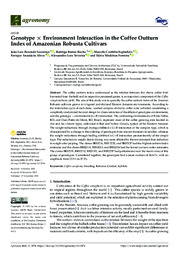Genotype × Environment Interaction in the Coffee Outturn Index of Amazonian Robusta Cultivars.
Genotype × Environment Interaction in the Coffee Outturn Index of Amazonian Robusta Cultivars.
Author(s): LOURENÇO, J. L. R.; ROCHA, R. B.; ESPINDULA, M. C.; ALVES, E. A.; TEIXEIRA, A. L.; FERREIRA, F. M.
Summary: The coffee outturn index, understood as the relation between the cherry coffee fruit harvested from the field and its respective processed grains, is an important component of the Coffea canephora bean yield. The aim of this study was to quantify the coffee outturn index of the Amazon Robusta cultivars grown in irrigated and dryland Western Amazon environments. According to the maturation cycle of each clone, washed samples of cherry coffee were collected considering a completely randomized factorial design for characterization of the effects of genotypes, environments, and the genotype × environment (G×E) interaction. The contrasting environments of Porto Velho, RO, and Ouro Preto do Oeste, RO, Brazil, represent most of the coffee growing sites located in Am and Aw climate types, cultivated in Red and Yellow Oxisols, typical of the Western Amazon. The weight reductions through drying exhibited a G×E interaction of the complex type, which is characterized by a change in the ordering of genotypes from one environment to another, whereas the weight reductions through hulling exhibited a G×E interaction predominantly of the simple type. The reduction in weight due to drying was more affected by the environment than reduction in weight after pulping. The clones BRS1216, BRS 3220, and BRS3137 had the highest outturn index estimates and the clones BRS2314, BRS3213, and BRS2336 had the lowest outturn index estimates. The clones BRS2299, BRS3210, BRS3193, and BRS2357 had performance near the mean value of this group of genotypes. Considered together, the genotypes had a mean outturn of 24.41%, with an amplitude from 22.5% to 27.2%
Publication year: 2022
Types of publication: Journal article
Unit: Embrapa Rondônia
Keywords: Breeding, Coffea Canephora, Hybrids, Robust
Observation
Some of Embrapa's publications are published as ePub files. To read them, use or download one of the following free software options to your computer or mobile device. Android: Google Play Books; IOS: iBooks; Windows and Linux: Calibre.
Access other publications
Access the Agricultural Research Database (BDPA) to consult Embrapa's full library collection and records.
Visit Embrapa Bookstore to purchase books and other publications sold by Embrapa.

